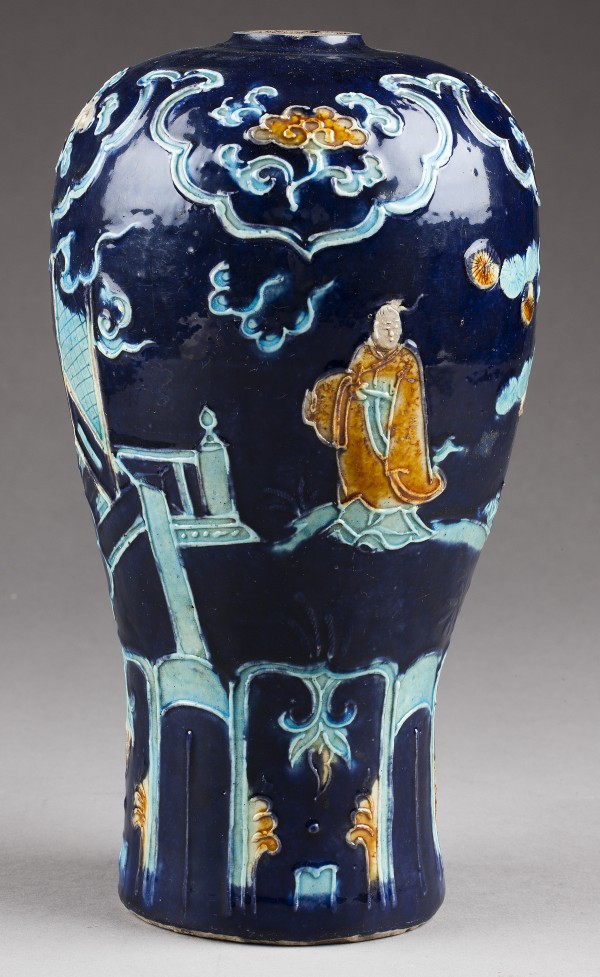
Porcelain meiping jar with slip-trailed and glazed decoration, the neck cut down. Ming dynasty, ca. 1500. Ceramics using raised lines of trailed slip to separate various glaze colors are known as fahua wares in China. Their reached a peak of popularity in the late 15th - early 16th century, when vessels of notable scale and complexity were made.
Image courtesy Hallwyl Museum, Stockholm.
Literal translation: "regulated decoration". This style of decoration on stoneware or porcelains resembles that of cloisonné metalwork. On fahua-decorated ceramics thin, raised slip lines are used to outline areas of the decoration. The unglazed porcelain object is fired and then enamels are applied to the individual areas created by the slip lines. The raised slip lines serve to inhibit enamels of different colors from flowing into each other. On stoneware pieces decorated in fahua style, a white slip coating is applied in order to provide a good surface onto which the enamels can be applied.
The term fahua refers to Chinese wares with bold decoration in deep blue, turquoise, purple, green, yellow, and white alkaline glazes. The motifs are usually outlined by raised trails of white slip. Because of this technique, fahua wares are regarded as the ceramic versions of cloisonné, where the design elements are separated by copper wires.
Fahua wares were produced from the fourteenth century, both in Shanxi province, northern China, and in southern China, probably at Jingdezhen, site of the imperial kilns. The high-fired porcelain body and palette employed are typical of those fahua wares made in southern China.
Fahua pieces are generally thickly potted. The decorative technique was used to ornament a wider range of vessel types including garden seats, wine jars and vases.
The fahua style of decoration appears to have first been developed on pottery or stoneware made in Shanxi province during the Yuan dynasty (some believe from Song), and early samples are rare. Jingdezheng started to make Fahua wares with porcelain body during Ming dynasty, Xuande reign (1426-35) to be popular during Ming. Original fahua disappeared after early Qing to be revived as much else for the decorative porcelain industry during the 20th century.
Fahua type ceramics can be traced as far back as the Yuan Period. Developed in the fifteenth century production continued through the sixteenth and seventh centuries. From Chenghua to Jiajing technique and production flourished. There seemed to be a lot of movement of these pieces within China but it seems that there was very little export of these pieces. Also reign marks on these pieces is rare. Most marks will be inscriptions.
There are two types of Fahua Ceramics. There is Northern Fahua and Southern Fahua. It is hard to determine which came first as the both started showing up in the Yuan Period at about the same time.
Northern Fahua Wares:
Northern fahua pieces are a low fired stoneware. Northern fahua wares are generally covered with a layer of slip which provides a white surface for decoration. Northern pieces typically have fugitive glazes that when lost show pinkish beige or buff stone ware body. This was due to the soft low fired lead alkaline glazes used on these pieces Northern pieces probably not made for everyday use as there bodies are soft and the glaze rubs off easily. These glazes were a lead Alkaline with saltpeter (potash) as the main flux. These glazes could be fired at 850-950 in a second firing that worked well with stone ware.
Southern Fahu Wares:
Southern fahua wares were made form high fired porcelain. There was no need to add slip as the bodies were all ready white. The glaze had a lower lead content and could be fired at a higher temperature and fit the body well and did not flake off.
Both Northern and Southern piece had both raise and incised raised slip and applied decoration. The Characteristic Fahua palette combines a selection of low fired over glazes. Turquoise, ink blue, amber yellow, aubergine, purple, emerald green and white.
It is believed that the term Fahua (designs with boundaries) started in the 1920s. There is no mention of Fahua in either Ming or Qing critical texts. Fahua ceramics are designs outlined in relief with trailed clay paste which creates cells. This is then fired and then the cell are filled with lead alkaline glazes and then refired. Some lines are incised and the glaze is contained by the incised lines. In the olden times the trailed lines were applied with a bag that had a small tube attached to it similar to a bakers piping bag. The soft porcelain was put in the bag and squeezed out through the tube to draw the outline of the motif cell. Today the potters use porcelain on a brush and apply it thickly into incised lines.
Early fahua pieces commonly had a horizontal motif. Later pieces commonly had vertical motif. Flowers for example would appear to be growing from the bottom of the vase and the motif would work up vertically.
In general Ming pieces tend to be large. Vases, wine jars, garden seats. During the Qing this technique was applied to smaller pieces.
A